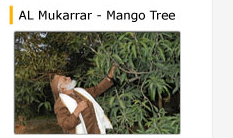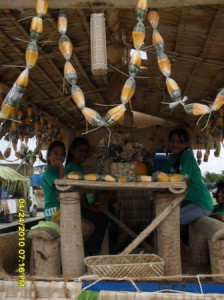- A Global Island Database for all you GIS geeks.
- African palms threatened by climate change: sensitive to climate, but constrained in their movement.
- But careful, it is easy to overestimate extinction risk when playing around with climate suitability models.
Beyond the staples
I haven’t been following the Millennium Villages literature — scientific and popular — quite as assiduously as I should, but what I have read does seem to focus quite strongly on the staple crops. No doubt a sustainable increase in the production of staples is necessary to combat hunger in Africa. But is it sufficient? The impression I have taken away from my reading is that that is not a question that is accorded high priority in this literature. If I’m wrong about this, I would welcome being set right. In any case, it came as a nice surprise to read the following passage in “Tripling crop yields in tropical Africa,” a recent article in Nature Geoscience by Prof. Pedro Sanchez, one of the moving forces behind the Millennium Villages project. 1
An increase in staple crop production is only a first step towards reducing hunger in tropical Africa. The provision of wider nutritional needs, such as more protein and adequate vitamins and trace elements, coupled with a reduction in disease, is also necessary.
Unfortunately that is not followed by a call to harness agrobiodiversity to provide those wider nutritional needs. But it does open an interesting door. A door that Bonnie McClafferty of HarvestPlus had no compunction about going through at SciDev.net a couple of days back:
The enormous challenge of micronutrient malnutrition is best addressed in the long run through poverty alleviation, economic development, education, women’s empowerment, access to adequate healthcare and dietary diversification, among other things.
Now, her defence of biofortification against the charge of medicalizing micronutrient deficiency sounds a lot like “don’t let the best be the enemy of the good,” which is a bit much, as in fact if anything it has been the good that’s been the enemy of the best in this game. Surely a lot more money has been going into biofortification than into dietary diversification — where, after all, is the latter’s equivalent of HarvestPlus? But it is good to see the importance of diverse diets — and by implication agrobiodiversity — at least recognized. Perhaps the Millennium Villages project could now plan some interventions around local vegetables and fruits?
Nibbles: Allanblackia domestication, Rampion census, Mali reforestation, Indian sacred groves, Oysters, Seaweeds, Breeding organics, EMBRAPA, Fisheries bycatch, Writing NUS proposals, Nutrition mag, Biofortification
- Boffins trying to domesticate Allanblackia for its oil.
- Phyteuma spicatum must be saved, British folklore depends on it. How about domesticating it?
- Farmers replanting forest in inland Niger delta. Sort of domesticating the forest, you mean?
- And here’s another domesticated forest, this time in Kerala.
- Are oysters domesticated? And seaweeds? Lots of uses for seaweeds, after all.
- Why plant breeding is incompatible with organic agriculture. Eh? First of a trilogy.
- Management of plant genetic resources in Brazil deconstructed.
- Oh dear, now boffins say avoiding bycatch may not be good after all.
- CTA calls for research notes in preparation for proposal writing workshop on neglected and underutilized plants.
- New Sight and Life magazine is out, with interesting discussions of Vitamin A supplementation in newborns and HIV patients.
- While at Scidev.net HarvestPlus defends biofortified crops against charge of medicalizing micronutrient deficiency.
The Three-hundred-variety mango of Malihabad
Another reflection on a remarkable Indian mango tree from our friend Bhuwon Sthapit of Bioversity International.
It is hard to believe that a farmer can have as a hobby the grafting of multiple varietal scions of interesting and unique mango diversity on to a single tree. I certainly did not believe it. Until I saw the orchard of Haji Kaleem Ullaj Khan in Malihabad. There he maintains several trees with many varieties grafted onto them as sources of scions for his mango nurseries. A good and reliable source of scions is essential to run a successful and credible mango nursery, but to have a conventional scion block is expensive in terms of maintenance and land.
The son of the magician grafter, Najmi, showed me two very remarkable mango trees. One is said to be 100 years old and is named Al-Muqarrar. It has had more than 300 varieties of mango skilfully grafted onto it by Najmi’s father father. The other, younger tree has more than 150 mango genotypes grafted on to it. Each branch looks like a different tree! Both trees are bearing fruits of different colour, shape and size, and at different times.
Born in 1945, Haji Kaleem Ullaj Khan does not have any academic horticultural degrees, but he is widely renowned in India for his skills and knowledge in multiple grafting on a single tree. He was awarded the title of Udhyan Pandit (Professor of the Orchard) by a former President of India. He has also presented a mango tree bearing 54 varieties to the current President for the premises of the Mughal Garden of Rastrapati Bhavan. He has been acknowledged by many high-profile visitors from abroad and also decorated with the Padamashri award. His name is recorded in the Guinness Book of World Records for his grafting feats.
 Abdullah Nursery is famous in Malihabad and throughout India for Haji Kaleem Ullaj Khan’s innovations, and markets saplings of commercial varieties to such distant places of Bhutan, Nepal and Bangladesh. Unlike government research stations, Haji Kaleem Ullaj Khan uses ground layering for his propagation for most commercial saplings, and veneer or wedge grafting in special cases. He has also grafted a guava tree that flowers and fruits all year round, which is another attraction for the nursery.
Abdullah Nursery is famous in Malihabad and throughout India for Haji Kaleem Ullaj Khan’s innovations, and markets saplings of commercial varieties to such distant places of Bhutan, Nepal and Bangladesh. Unlike government research stations, Haji Kaleem Ullaj Khan uses ground layering for his propagation for most commercial saplings, and veneer or wedge grafting in special cases. He has also grafted a guava tree that flowers and fruits all year round, which is another attraction for the nursery.
This innovation borne out of local need is a promising way for nurseries to maintain many scions at relatively low cost. However, this can be a high risk practice, because many varieties depend on one mother tree’s survival. It is thus important to have adequate safety duplication or maintain some scion material trees separately. Multiple variety grafting can also be used as an attraction in agrotourism, and for innovative marketing of diversity in urban and home gardens. This will create a new market for nursery growers and raise public interest in the diversity of mangoes. This activity has been conceptualized in the context of the UNEP/GEF project Conservation and Sustainable Use of Tropical Fruit Tree Diversity in India.
Bob is healthy
Via Lois Englberger comes news of Bob Festival Day in the Marshall Islands last Saturday, 24 April. Bob is not some guy, but rather the Pandanus tree. Lois shared Lydia Tibon’s description of the event, which we reproduce below. Pandanus is very important throughout the Pacific, where it has multiple uses. Lois is particularly interested in its beta carotene content. Our thanks to both her and Lydia.
KIJLE (Kora in Jiban Lolorjake Ejmour), meaning “women assisting to promote good health,” participated. We wanted to remind everyone that Bob is better than eating processed foods.
As you can see, the table, chairs, everything hanging and inside our float were pandanus-made. Our kids, grannies were chewing and throwing bobs to everyone. Our billboard message was to promote both education and health.
Our motto is Bob Dikdik Kejadikdrik, the translation is something like “Bob is so fruitful.” It produces so much, it gives us so much knowledge that we use the leaves by weaving the mats, making hats, use to drink medicines, also gives Vitamin A that is very rich to protect our skin, vision, bones and many more….
Our T/shirt that day was “Bob is healthy.”
